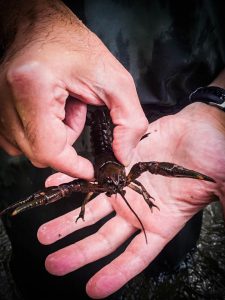In 2016, two species of Appalachian crayfish, the Big Sandy Crayfish (Cambarus callainus) and the Guyandotte River Crayfish (C. veteranus) were awarded federal protection under the Endangered Species Act. Due to their limited range and degrading habitat, the Big Sandy Crayfish was designated as a threatened species and the Guyandotte River Crayfish was designated as an endangered species. These designations provide each species protections through United States Fish and Wildlife Service (USFWS) management and oversight of activities which may alter species distribution and/or habitat.
The Big Sandy Crayfish (C. callainus) was first observed in 1937 and is only known from the Big Sandy River watershed in eastern Kentucky, southwestern Virginia, and southern West Virginia. More specifically, it is only found in McDowell and Mingo Counties within West Virginia. The Big Sandy Crayfish is currently considered threatened because of its potential to become endangered if populations continue to decline in number and habitats continue to become limited.
The Guyandotte River Crayfish (C. veteranus) is currently only known to occur in two streams of its historic range in Wyoming County, West Virginia. The species has a well-known population in Pinnacle Creek and a recently found population in Clear Fork. The Guyandotte River Crayfish is considered to be endangered because known populations are small and are isolated from each other. This makes the species vulnerable to die-offs as result of single pollution events and lack of genetic diversity.
Both species are habitat specialists, meaning they have specific habitat requirements for the establishment and success of their populations. Large slab boulders within swift moving creeks and streams are the preferred refugia for both species. Unfortunately, these habitats can become increasingly scarce as a result of increased sediments to streams such as sand and silt. In addition, historic industrial activities and poor infrastructure in the region have also resulted in water quality issues throughout each species’ historic range.
With habitat availability declining, these two-protected species are forced to compete with common native crayfish species for resources and refugia. Interspecies competition can further inhibit the likelihood of their success.
Crayfish Presence/Absence Surveys
AllStar Ecology has a team of aquatic biologists who conduct threatened and endangered crayfish surveys in the southern coalfields of West Virginia, Virginia, and beyond. With multiple staff members having passed identification and survey protocol testing, AllStar Ecology can deploy teams of aquatic biologists to conduct the necessary surveys.
Over the past two years, our biologists have conducted numerous presence/absence surveys in McDowell, Logan, and Wyoming Counties, West Virginia for bridge enhancement projects and utility lines. Due to the instream work associated with these projects, the surveys were necessary to avoid potential disturbance to endangered crayfish and their habitats.
Having previously worked with federal and state agencies on threatened and endangered crayfish surveys, AllStar has the experience and knowledge to develop survey plans and conduct the necessary surveys to fulfill the needs of your project. Learn more about all of our services by clicking here or contact us for more information.




